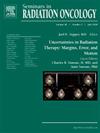Elective Regional Nodal Irradiation in Prostate Cancer
IF 3.2
3区 医学
Q3 ONCOLOGY
引用次数: 0
Abstract
Elective nodal radiotherapy (ENRT) targets microscopic pelvic lymph node metastases to improve locoregional control in prostate cancer. Recent randomized trials report improved outcomes, particularly in high-risk cohorts, albeit with modest increases in Grade 2 gastrointestinal (GI) and genitourinary (GU) toxicities. Molecular imaging has markedly refined patient selection, enabling precise identification of occult nodal disease and enhancing application of ENRT beyond traditional clinical parameters. Modern radiation therapy approaches, including image-guided intensity-modulated radiotherapy (IMRT) and stereotactic body radiotherapy (SBRT), have enhanced ENRT efficacy and safety by employing stringent organ-at-risk constraints. Recent evidence supports SBRT-based ENRT (25 Gy in 5 fractions), demonstrating both efficacy and acceptable toxicity profiles. In the postoperative adjuvant context, ENRT shows promise for patients with pathological nodal involvement (pN+), particularly those with ≥3 positive nodes, high-grade disease, or positive surgical margins. In the salvage setting, combining ENRT with short-term androgen deprivation therapy (ADT) may benefit patients with biochemical recurrence and adverse pathological features, even in node-negative cases. Until definitive data emerges from ongoing randomized trials, multidisciplinary evaluation and integration of modern imaging and radiotherapy techniques remain essential for optimal ENRT in prostate cancer.
前列腺癌选择性局部淋巴结照射
选择性淋巴结放疗(ENRT)靶向盆腔淋巴结转移以改善前列腺癌的局部控制。最近的随机试验报告了改善的结果,特别是在高风险队列中,尽管2级胃肠道(GI)和泌尿生殖系统(GU)毒性略有增加。分子成像显著改善了患者选择,能够精确识别隐匿性淋巴结疾病,并增强了ENRT在传统临床参数之外的应用。现代放射治疗方法,包括图像引导的调强放疗(IMRT)和立体定向体放疗(SBRT),通过采用严格的器官危险限制,提高了ENRT的疗效和安全性。最近的证据支持基于sbrt的ENRT(5份25 Gy),显示出疗效和可接受的毒性特征。在术后辅助治疗方面,ENRT对病理性淋巴结受累(pN+)的患者,特别是那些≥3个阳性淋巴结、高度病变或手术切缘阳性的患者显示出希望。在挽救方面,ENRT联合短期雄激素剥夺治疗(ADT)可能有利于生化复发和不良病理特征的患者,即使是淋巴结阴性的病例。在正在进行的随机试验中获得明确的数据之前,多学科评估和现代成像和放疗技术的整合对于前列腺癌最佳ENRT仍然至关重要。
本文章由计算机程序翻译,如有差异,请以英文原文为准。
求助全文
约1分钟内获得全文
求助全文
来源期刊
CiteScore
5.80
自引率
0.00%
发文量
48
审稿时长
>12 weeks
期刊介绍:
Each issue of Seminars in Radiation Oncology is compiled by a guest editor to address a specific topic in the specialty, presenting definitive information on areas of rapid change and development. A significant number of articles report new scientific information. Topics covered include tumor biology, diagnosis, medical and surgical management of the patient, and new technologies.

 求助内容:
求助内容: 应助结果提醒方式:
应助结果提醒方式:


